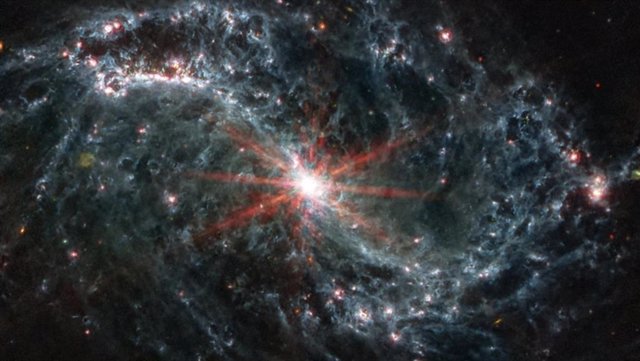March 9 () –
A team of researchers has been able to see for the first time the interior of distant spiral galaxies to study how they formed and how they change over timethanks to the Webb Space Telescope.
“We are studying 19 of our closest analogues to our own galaxy.. In our own galaxy we cannot make many of these discoveries because we are trapped inside it“, it states it’s a statement Erik Rosolowsky, a professor in the Department of Physics at the University of Alberta and co-author of a recent paper analyzing data from the James Webb telescope.
Unlike previous observing tools, the telescope’s mid-infrared instrument can penetrate dust and gas clouds to provide fundamental information about how stars are forming in these galaxies, and consequently how stars are forming in these galaxies. how they are evolving
“This is light that has a longer wavelength and represents objects that are cooler than the light we see with our eyes,” explains Rosolowsky. “Infrared light is really key to tracing the cold and distant universe.”
Until now, the telescope has captured data on 15 of the 19 galaxies. Rosolowsky and Hamid Hassani, a doctoral student and lead author of the paper, examined the infrared light emitted by dust grains at different wavelengths to help categorize what they were seeing, such as whether an image showed regular stars, massive complexes star formation or background galaxies.
“At 21 micrometers [la longitud de onda infrarroja utilizada para las imágenes recogidas]if you observe a galaxy you will see all those grains of dust heated by the light of the starsHassani explains.
From the collected images, they were able to determine the age of the stars. They found they were looking at young stars that “burst onto the scene almost instantly, much faster than many models had predicted“, says Rosolowsky.
“The age of these populations [estelares] it’s very young. They are really starting to produce new stars and are very active in star formation,” Hassani says.
The researchers also found a close relationship between the mass of stars in a region and their brightness. “It turns out that this was a brilliant way to find high-mass stars,” says Rosolowsky.
Rosolowsky calls high-mass stars “rock stars” because they “live fast, die young, and really shape the galaxy around them.” When they are forming, he explains, they release enormous amounts of solar wind and gas bubbles, which halt star formation in that particular area while stirring up the galaxy and triggering star formation in other areas.
“We’ve found that this kind of bubbly foam is really key to a galaxy’s long-term life, because it prevents the galaxy from running out of fuel too quickly,” Rosolowsky explains.
It is a complex process, in which each new stellar formation plays a larger role in the evolution of the galaxy over time, adds Hassani.
“If you have a star forming, that galaxy is still active. There’s a lot of dust and gas and all these emissions from the galaxy that trigger the next generation of massive star formation. and keep the galaxy alive.”
The more images scientists have that document these processes, the better they can deduce what happens in distant galaxies that have similarities to our own. Rather than take a deep look at a single galaxy, Rosolowsky and Hassani want to create what Rosolowsky calls a kind of “atlas of galaxies” by capturing images using as many methods as possible.
“By collecting all this data, by creating this great atlas, we would be able to distinguish what is special about a galaxy from the unifying themes that shape galaxies as a whole,” says Rosolowsky.
Their paper is one of 21 research papers on the initial results of the Physics at High Angular resolution in Nearby Galaxies (PHANGS) collaboration, published in a special issue of The Astrophysical Journal Letters.














